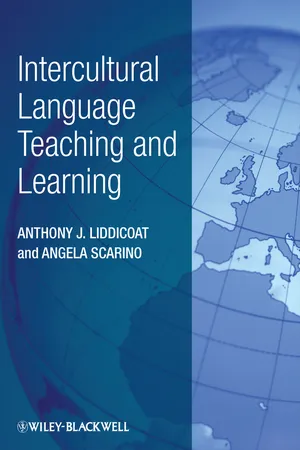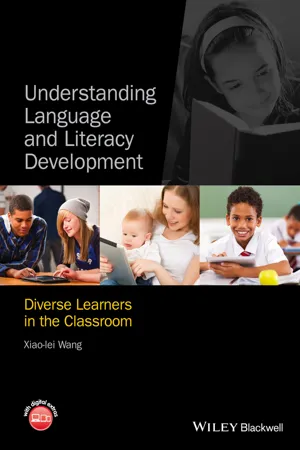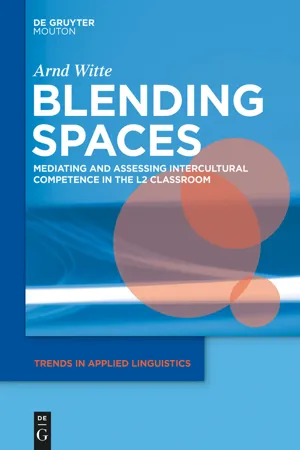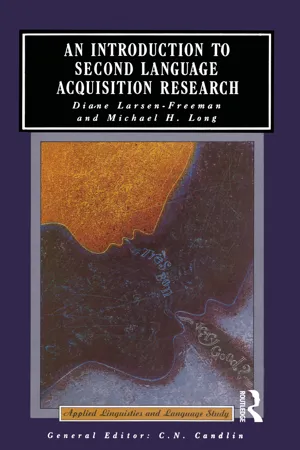Languages & Linguistics
Theories of Language Acquisition
Theories of language acquisition are explanations for how individuals learn and develop language skills. These theories include behaviorist approaches, which emphasize imitation and reinforcement, as well as nativist theories, which propose that humans have an innate capacity for language. Additionally, interactionist perspectives suggest that both biological and environmental factors play a role in language development.
Written by Perlego with AI-assistance
Related key terms
6 Key excerpts on "Theories of Language Acquisition"
- eBook - ePub
- Anthony J. Liddicoat, Angela Scarino(Authors)
- 2013(Publication Date)
- Wiley-Blackwell(Publisher)
In each of these nine categories, Ellis identifies the current state of play with respect to the defining characteristics and distinctions that are made between the families of theories. In relation to each of these categories we argue that when language learning is understood within an intercultural orientation each of these categories needs to be expanded further to recognize learning as interlinguistic and intercultural (Byrnes, Maxim, and Norris, 2010) and as interpretive (Scarino, 2010). Interestingly, in the research methodology category outlined by Ellis, the interpretive characteristic is captured within the social SLA.Before discussing more fully the nature and value of such an expanded view of learning, we provide a brief history of the development of these families of theories of SLA to better situate our understandings of second language learning.A Brief History of the Development of Theories of Language Learning
Cognitive Theories of Language Acquisition developed as a reaction to behaviorism. The behaviorist view was challenged by Chomsky (1959), who claimed that children are born with a capacity for language, just as they are born with an ability to learn to walk, and that it is neither taught nor learned but it just grows. This innatist view of language acquisition states that beyond imitation and practice children have a language acquisition device in the brain which allows them to discover the rules of a language system; experience of natural language activates the device, which enables learners to discover the structure of the language to be learned by matching the structures of language in their environment with their innate knowledge of basic grammatical relationships. This capability, related to innate knowledge of principles of Universal Grammar, enables children to develop their language ability beyond the actual input that they have received. This is the creativity of language; children create sentences that they have never learned before. The evidence for this view comes from the fact that all children successfully learn their home language, that they do so under highly diverse conditions, and that they learn to use language beyond the instances of their immediate experience. The evidence that they are applying rules rather than imitating language around them comes from utterances such as “she goed to the shop.” While Chomsky essentially worked within first language situations, there has been subsequent consideration about whether his theory also pertains to SLA and, if so, how exactly it is that Universal Grammar works in the learning of subsequent languages (e.g. White, 2003). At this same time there was a shift from structural linguistic, which considered the surface structure of language, to generative linguistic, which considered language as rule-governed and creative. - eBook - ePub
Understanding Language and Literacy Development
Diverse Learners in the Classroom
- Xiao-lei Wang(Author)
- 2014(Publication Date)
- Wiley-Blackwell(Publisher)
He taked my toy.” Nor can it explain why children with TD acquire a language in a short period (usually over about four to five years) and are able to produce sentences that they have never heard before (S. Brown and Attardo, 2008; Owens, 2012).Although the behaviorist theory's explanation of childhood language acquisition is limited, it should not be dismissed entirely, for two reasons. First, it has historically contributed to the development of sociolinguistic theories. Second, its emphasis on “stimulus (model)-response (imitate)-reinforcement” is still quite useful for children with LI (Owens, 2012).Your Turn
What is your position on the behaviorist perspective of language acquisition? Support your position with examples from this textbook.Nativist theory
As briefly mentioned in Chapter 2, Noam Chomsky proposed an opposite explanation to the behaviorist position regarding how children acquire a language. According to this theoretical perspective, language is a symbolic system that is innate, residing in the human genetic code. Language acquisition is a universal, stable, orderly, and stage-like process. He suggested that children are born with general grammatical rules and categories common to all languages (the universal grammar). With this inborn language acquisition device (LAD), children use environmental input to discover the parameters/framework their language uses to satisfy the general grammatical rules and categories they are born with. Such innate ability is especially evident in the acquisition of syntactic rules.As suggested in Chapter 2, there is evidence to support this view such as situations where children acquire creole and deaf children of hearing parents create language-like gestural communication systems. However, the nativist theory gives less credit to the role of input in language learning. There is ample evidence to suggest that adult input does make a difference in the frequency and quality of children's language learning. For example, research shows that parental vocabulary input is connected to children's vocabulary growth and that talkative parents have more talkative children (e.g., Huttenlocher et al., 1991). - eBook - ePub
Introducing Second Language Acquisition
Perspectives and Practices
- Kirsten M. Hummel(Author)
- 2013(Publication Date)
- Wiley-Blackwell(Publisher)
There is considerable evidence for the biological basis for language that the UG approach emphasizes. As pointed out earlier in this chapter, children manifest an early sound perception discrimination ability that appears to fade away if the sound contrasts are not used in the language of the child's environment. We have also noted the developmental similarities in stages and the fact that certain milestones are attained in a similar sequence and at generally similar times (babbling, first word, two-word sequences, etc.). Such evidence has been used to support the notion that children are indeed “prewired” to acquire language.On the other hand, others point out that the linguistic view gives too little attention to the role of the environment and the crucial role played by interaction between the child and his or her social network, as discussed in the following section.2.3.3 interactionist approach
Interactionismand interactionist approaches to explaining L1 acquisition give explicit acknowledgment to the contribution of both innate structures and the role of the environment. In particular, the social interactionist view, which includes proponents such as Berko Gleason, the creator of the Wug test discussed in an earlier section, argues that while there is substantial evidence that innate structures allow for language acquisition, the role of the environment is more important than acting as a simple trigger for development, as proposed in the linguistic approach. Social interactionists give importance to the interplay between linguistic structures, cognitive abilities, and the social and linguistic environment. Language is viewed as a communicative act and the language environment and the child constitute a dynamic system. Piper (1998, p. 161) sums up this approach in the following way:The question that is of primary interest in language acquisition theory is how children acquire the ability to express their intentions or meanings in language. [Social] interactionists believe that they do so through a process of negotiation with their mothers or principal caregivers. This negotiation occurs partly as a result of mothers treating children's speech, even if it is babbling, as meaningful and intentional. - eBook - ePub
Introducing Second Language Acquisition
Perspectives and Practices
- Kirsten M. Hummel(Author)
- 2020(Publication Date)
- Wiley-Blackwell(Publisher)
There is considerable evidence for the biological basis for language that the UG approach emphasizes. As pointed out earlier in this chapter, children manifest an early sound perception discrimination ability that appears to fade away if the sound contrasts are not used in the language of the child's environment. We have also noted the developmental similarities in stages and the fact that certain milestones are attained in a similar sequence and at generally similar times (babbling, first word, two‐word sequences, etc.). Such evidence has been used to support the notion that children are indeed “prewired” to acquire language.On the other hand, others point out that the linguistic view gives too little attention to the role of the environment and the crucial role played by interaction between the child and his or her social network, as discussed in the following section.2.4.3 L1 interactionist approach
Interactionismand interactionist approaches to explaining L1 acquisition give explicit acknowledgment to the contribution of both innate structures and the role of the environment. In particular, the social interactionist view, which includes proponents such as Berko Gleason, the creator of the Wug test discussed in Section 2.3 , argues that while there is substantial evidence that innate structures allow for language acquisition, the role of the environment is more important than acting as a simple trigger for development, as proposed in the linguistic approach. Social interactionists give importance to the interplay between linguistic structures, cognitive abilities, and the social and linguistic environment. Language is viewed as a communicative act and the language environment and the child constitute a dynamic system. Piper (1998 , p. 161) sums up this approach in the following way:Theoretical viewpoint about L1 acquisition that recognizes the role of experience and the environment, as well as the contribution of innate capacities.interactionismThe question that is of primary interest in language acquisition theory is how children acquire the ability to express their intentions or meanings in language. [Social] interactionists believe that they do so through a process of negotiation with their mothers or principal caregivers. This negotiation occurs partly as a result of mothers treating children's speech, even if it is babbling, as meaningful and intentional. - eBook - ePub
- Arnd Witte(Author)
- 2014(Publication Date)
- De Gruyter Mouton(Publisher)
2 First language acquisition and early cognitive developmentWhen starting to learn a second language, most adult learners do so, intentionally or not, with reference to their previously internalized linguistic and cultural patterns for construal, as well as social norms and conventions of the L1 community. Since these have been acquired early in life in tandem with the process of developing mental functions, feelings, and plausibility structures, they have a deeply formative influence on all activities carried out by the subject, including learning another language and its use in sociocultural contexts. In this chapter, the acquisition of these influential L1 patterns and structures will be analyzed.Development, change, and transformation are central notions, not only for the complex constructs of culture and society, but also for the no less complex cognitive and emotional capacities of the individual; this is particularly evident in the constantly ongoing activities of learning. Throughout biological life, the mental functions of the individual never cease to develop (and this can include regressive development). The largest leap in individual development, be it physical or psychological, takes place in the first fifteen years of life, during infancy, childhood, and early adolescence. And within this time-span, the first months and years are a crucial period, during which children acquire the basic structures of knowledge through participatory, intersubjective engagement with others and Other. These basic structures are mediated by culturally-constructed symbolic sign systems, among which language is by far the most diverse and complex mediator. Language is a highly sensitive instrument for linking cognitive, semiotic, and social activities. Mediation is a hugely important process by which culturally constructed artifacts (first and foremost language), concepts, values, norms, beliefs, and frames are increasingly used to regulate intra- and intersubjective mental activities (i.e., thought and interaction). The structures and patterns of the first language, society, and culture have repercussions for the process of second language learning because of their normative influence on thought, emotion, and behavior; the L2 is approached from the linguistic, cultural, and psychological bases of the L1-mediated constructs. They are also relevant since the deeply ingrained tacit linguistic, conceptual, and cultural knowledge is usually taken to be universally valid by the person – an assumption which will be fundamentally unsettled by the experience of learning another language. Therefore, this chapter will analyze the acquisition of fundamental concepts and categories through the medium of the first language; a process that constitutes and transforms the subjective mind by immersion in linguistic, social, and cultural practices of the immediate environment of family, peers, playground, and school. - Diane Larsen-Freeman, Michael H. Long(Authors)
- 2014(Publication Date)
- Routledge(Publisher)
, Chapter 10: Theories of second language acquisition. Oxford University PressGregg, K (In press) Krashen's theory, acquisition theory, and theory. In Barasch, R (ed.) Responses to Krashen . Newbury House, Cambridge, Mass.Larsen-Freeman, D 1983c Second language acquisition: getting the whole picture. In Bailey, K, Long, M and Peck, S (eds.) Second language acquisition studies , pp. 3-22. Newbury House, Rowley, Mass.Long, M 1985 Input and second language acquisition theory. In Gass, S and Madden, C (eds.) Input and second language acquisition , pp. 377-93. Newbury House, Rowley, Mass.McLaughlin, B 1987 Theories of second language learning . Edward ArnoldOchsner, R 1979 A poetics of second language acquisition. Language Learning 29 (1): 53-80Schumann, J 1983 Art and science in second language acquisition research. In Clark, M and Handscombe, J (eds.) On TESOL '82 . TESOL, Washington, D.C.Spolsky, B 1989 Conditions for second language learning . Oxford University PressFor Chomsky's Universal Grammar and SLA, see:Cook, V 1985 Chomsky's universal grammar and second language acquisition. Applied Linguistics 6 : 2-18Cook, V 1988 Chomsky's universal grammar . Basil Blackwell, New YorkGregg, K 1989 Linguistic perspectives on second language acquisition: what could they be, and where can we get some? In Gass, S and Schachter, J (eds.) Linguistic perspectives on second language acquisition . Cambridge University PressPankhurst, J, Sharwood-Smith, M and van Buren, P (eds.) 1988 Leamability and second languages . Foris, DordrechtRitchie, W 1983 Universal grammar and second language acquisition. In Rogers, D and Sloboda, J (eds.) The acquisition of symbolic skills . Plenum Press, New YorkRutherford, W 1986 Grammatical theory and L2 acquisition: a brief overview. Second Language Research 2 : 1-15White, L 1986 Implications of parametric variation for adult second language acquisition: an investigation of the pro-drop parameter. In Cook, V (ed.) Experimental approaches to second language acquisition .
Learn about this page
Index pages curate the most relevant extracts from our library of academic textbooks. They’ve been created using an in-house natural language model (NLM), each adding context and meaning to key research topics.





